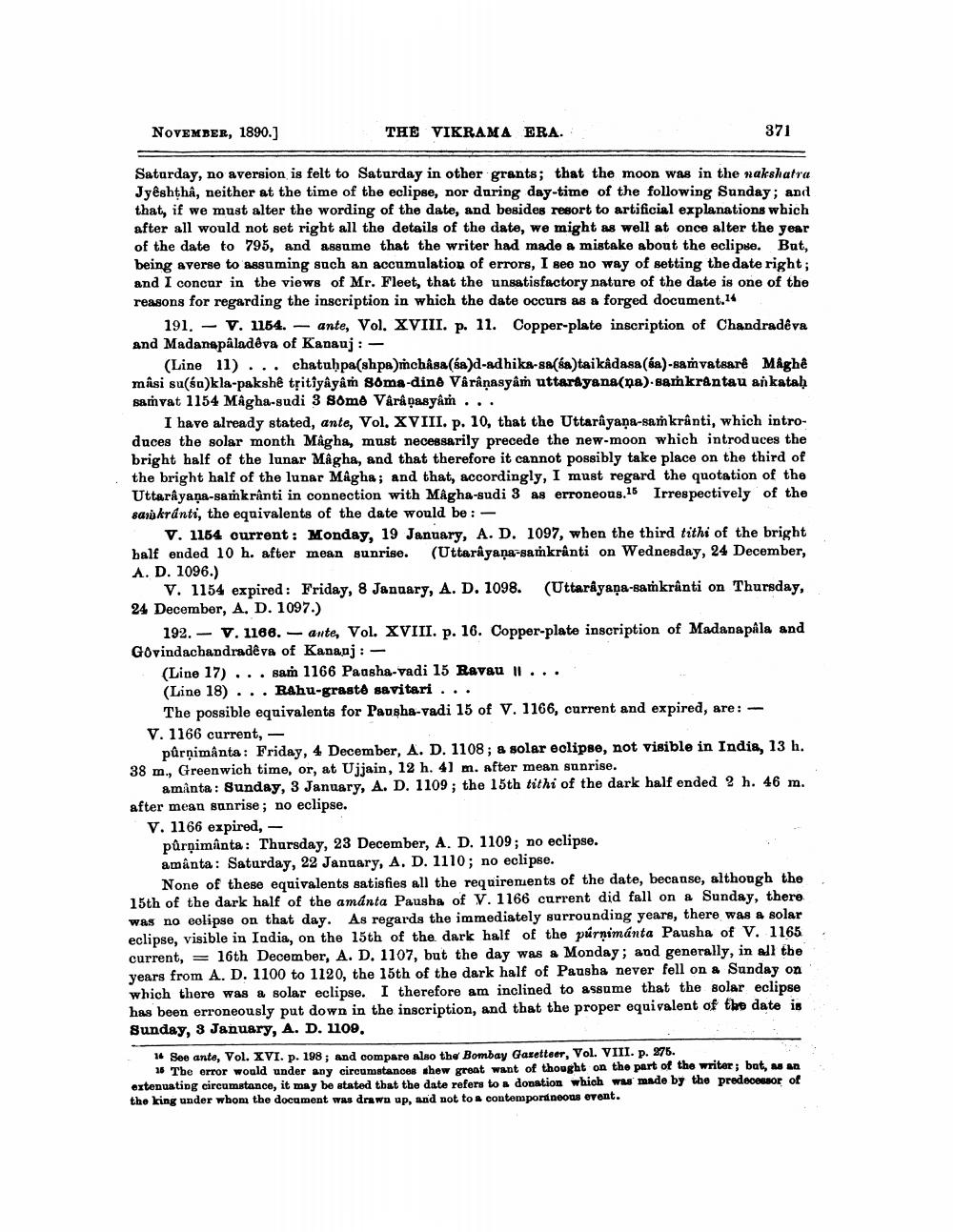________________
NOVEMBER, 1890.]
THE VIKRAMA ERA.
371
Saturday, no aversion is felt to Saturday in other grants; that the moon was in the nakshatra Jyêshthâ, neither at the time of the eclipse, nor daring day-time of the following Sunday; and that, if we must alter the wording of the date, and besides resort to artificial explanations which after all would not set right all the details of the date, we might as well at once alter the year of the date to 795, and assume that the writer had made a mistake about the eclipse. But, being averse to assuming such an accumulation of errors, I see no way of setting the date right; and I concur in the views of Mr. Fleet, that the unsatisfactory nature of the date is one of the reasons for regarding the inscription in which the date occurs as a forged document.14
191. – V. 1164. — ante, Vol. XVIII. p. 11. Copper-plate inscription of Chandradeva and Madanapaladdva of Kanauj: -
(Line 11) ... chatuhpa(shpa)mchâsa(sa)d-adhika-sa(ka)tai kadasa (sa)-samvatsare Maghe miisi su(so)kla-pakshe tritîyayên Soma-dinė Vârâņasyâm uttarayana(pa) samkrantau ankatah samvat 1154 Magha-sudi 3 Some Váránasyam...
I have already stated, ante, Vol. XVIII. p. 10, that the Uttarâyaņa-saṁ krânti, which introduces the solar month Mâgha, must necessarily precede the new-moon which introduces the bright half of the lunar Mâgha, and that therefore it cannot possibly take place on the third of the bright half of the lunar Magha; and that, accordingly, I must regard the quotation of the Uttarayana-sankranti in connection with Magha-sudi 3 as erroneous.15 Irrespectively of the saro kranti, the equivalents of the date would be : -
V. 1154 ourrent: Monday, 19 January, A. D. 1097, when the third tithi of the bright balf ended 10 h. after mean sunrise. (Uttarayaņa-sankranti on Wednesday, 24 December, A. D. 1096.)
V. 1154 expired: Friday, 8 January, A. D. 1098. (Uttarayana-sankranti on Thursday, 24 December, A. D. 1097.)
192. - V. 1188. - ante, Vol. XVIII. p. 16. Copper-plate inscription of Madanapala and Govindachandradêva of Kananj: -
(Line 17)... sam 1166 Paasha-vadi 15 Ravau 11... (Line 18)... RAhu-grasto savitari ...
The possible equivalents for Pausha-vadi 15 of V. 1166, current and expired, are: - V. 1166 current, —
půrņimanta: Friday, 4 December, A. D. 1108; & solar eclipse, not visible in India, 13 h. 38 m., Greenwich time, or, at Ujjain, 12 h. 41 m. after mean sunrise.
aminta: Sunday, 3 January, A. D. 1109; the 15th tithi of the dark half ended 2 h. 46 m. after mean sunrise; no eclipse. V. 1166 expired, -
půrnimânta: Thursday, 23 December, A. D. 1109; no eclipse. amânta: Saturday, 22 January, A. D. 1110; no eclipse.
None of these equivalents satisfies all the requirenients of the date, because, althongh the 15th of the dark half of the amanta Pausha of y. 1166 current did fall on a Sunday, there. was no eclipse on that day. As regards the immediately surrounding years, there was a solar eclipse, visible in India, on the 15th of the dark half of the purnimanta Pausha of V. 1165 current, = 16th December, A. D. 1107, but the day was a Monday; and generally, in all the years from A. D. 1100 to 1120, the 15th of the dark half of Pausha never fell on a Sunday on which there was a solar eclipse. I therefore am inclined to assume that the solar eclipse has been erroneously put down in the inscription, and that the proper equivalent of the date is Sunday, 3 January, A. D. 1109.
* See ante, Vol. XVI. p. 198; and compare also the Bombay Garetteer, Vol. VIII. p. 875.
16 The error would under any circumstances shew great want of thought on the part of the writer; bat, as an oxtenuating circumstance, it may be stated that the date refers to a donation which was made by the predecessor of the king under whom the document was drawn up, and not to a contempordneous event.




